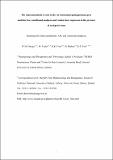The endocannabinoid system in the rat dorsolateral periaqueductal grey mediates fear-conditioned analgesia and controls fear expression in the presence of nocicpetive tone

View/
Date
2011Author
Olango, W.M.
Roche, Michelle
Ford, Gemma K.
Harhen, Brendan
Finn, David P.
Metadata
Show full item recordUsage
This item's downloads: 707 (view details)
Recommended Citation
Olango WM, Roche M, Ford GK, Harhen B, Finn DP (2011). The endocannabinoid system in the rat dorsolateral periaqueductal grey mediates fear-conditioned analgesia and controls fear expression in the presence of nocicpetive tone. British Journal of Pharmacology
Published Version
Abstract
Background and purpose: Endocannabinoids in the midbrain periaqueductal grey (PAG) are involved in modulating nociception and unconditioned stress-induced analgesia, however, their role in fear-conditioned analgesia (FCA) has not been examined. The present study examined the role of the endocannabinoid system in the dorsolateral (dl) PAG in formalin-evoked nociceptive behaviour, conditioned fear and FCA in rats.
Experimental approach: Rats received intra-dlPAG administration of the CB1 receptor antagonist/inverse agonist rimonabant, or vehicle, prior to re-exposure to a context paired 24hrs previously with footshock. Formalin-evoked nociceptive behaviour and fear-related behaviours (freezing and 22kHz ultrasonic vocalisation) were assessed. In a separate cohort, alterations in levels of endocannabinoids (2-arachidonoyl glycerol [2-AG] and N-arachidonoyl ethanolamide [anandamide; AEA]) and the related N-acylethanolamines (NAEs) (N-palmitoyl ethanolamide [PEA] and N-oleoyl ethanolamide [OEA]) were measured in dlPAG tissue following re-exposure to conditioned context in the presence or absence of formalin-evoked nociceptive tone.
Key results: Re-exposure of rats to the context previously associated with footshock resulted in FCA. Intra-dlPAG administration of rimonabant significantly attenuated FCA and fear-related behaviours expressed in the presence of nociceptive tone. Conditioned fear in the absence of formalin-evoked nociceptive tone was associated with increased levels of the endocannabinoids (2-AG and AEA) and NAEs (PEA and OEA) in the dlPAG. FCA was specifically associated with an increase in AEA levels in the dlPAG.
Conclusions and implications: These data suggest that conditioned fear to context mobilises endocannabinoids and NAEs in the dlPAG and support a role for the endocannabinoid system in the dlPAG in mediating the potent suppression of pain responding which occurs during exposure to conditioned aversive contexts.

